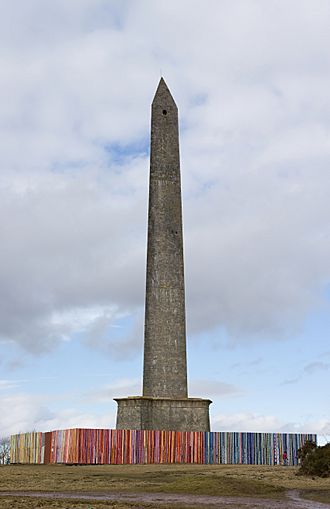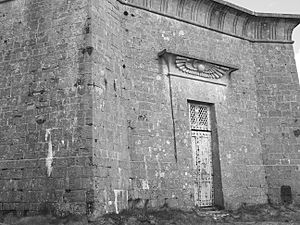Wellington Monument, Somerset facts for kids
Quick facts for kids Wellington Monument |
|
|---|---|

Wellington Monument, with painted site barrier in place at the base due to renovation works
|
|
| General information | |
| Location | Wellington, England |
| Coordinates | 50°56′53″N 3°13′45″W / 50.9480°N 3.2293°W |
| Construction started | 1817 |
| Completed | 1854 |
| Technical details | |
| Size | 175 feet (53 m) high |
| Design and construction | |
| Architect | Thomas Lee |
The Wellington Monument is a huge, triangular stone tower, about 175-foot-high (53 m). It stands on a hill called the Blackdown Hills, about 3 km (1.9 miles) south of Wellington in England. This monument is a special historic building, known as a grade II* listed building. It is the tallest three-sided tower of its kind in the whole world!
This amazing monument was built to remember the Duke of Wellington's big win at the Battle of Waterloo. Building started in 1817, but they ran out of money. A simpler, cheaper design was finally finished in 1854. Today, the National Trust owns it. They closed it in 2007 because it wasn't safe. The monument needs a lot of repair work to open its inside staircase again. As of 2020, the repairs are still happening.
Contents
Building the Monument
The Wellington Monument was built to celebrate the Duke of Wellington's victory at the Battle of Waterloo. After another battle, the Battle of Talavera, Wellesley became a duke. Since he was away, his brother picked the town of Wellington for his new title. This was because it sounded like his family name, even though the Duke had never been there.
The government gave him £100,000. With this money, he bought land in the town, including where the monument now stands. In 1815, a local man named William Sanford suggested building the monument. He started collecting money from people. Soon, £1450 was raised.
They held a competition to pick a design. The winning idea was for a 95 feet (29 m) pillar with three small houses at the bottom. These houses were meant for old soldiers to live in and look after the monument. Thomas Lee designed it. The first stone was laid in 1817. By 1818, the column was 47 feet (14 m) high, but all the money was gone. More money was raised, and the column grew to 121 feet (37 m) by 1820. In 1846, lightning struck and damaged it.
Building started again after the Duke of Wellington passed away. The monument was finally finished in 1854. Its design looks like an Egyptian obelisk. It also looks like a bayonet, a type of knife used by Wellington's soldiers. The first plans included a metal statue of the Duke on top. There were also plans for more statues at the base, but these were never built. In 1890, the very top of the monument was repaired and made 1.5 metres (4.9 ft) taller.
Cannons at the Base
The first plans for the monument included twenty-four cannons. These cannons were captured from the French army at the Battle of Waterloo. They were supposed to be placed around the base. In 1818, one brass and 15 iron cannons were brought from London to Exeter. However, they never made it to the monument.
After many years in storage, ten cannons were buried in the ground to be used as bollards (short posts). The brass cannon was sold in 1837 to pay for storage costs. In 1890, four cannons were requested for the monument. But they found out these were naval cannons made in Scotland in 1789. They had never been used in the Battle of Waterloo.
Four cannons were finally put around the monument in 1910. However, they were taken away during the Second World War (1939–1945). They were meant to be melted down for scrap metal to help the war effort. But the need for scrap metal went down, so they were buried instead. The one cannon left in Exeter was brought to the monument in 1977. It was finally put in place in 1984.
Monument's Design
The Wellington Monument is made from local stone called Calcareous Grit. This is a type of Sandstone. The triangular tower is 80 feet (24 m) wide at its bottom. It stands 175 feet (53 m) tall. The base has a special Egyptian-style panel above its strong iron door.
Inside the very top of the monument, there is a counterweight. This helps to keep the tall tower balanced when it's windy. There is also a staircase inside that goes up to a viewing platform. From this platform, you can look out through three round windows, one on each side.
Owned by the National Trust
The National Trust took over the monument in the 1930s. On special days, the monument is lit up at night. New lights were put in place in 2015. In 1985, a local group called the Wellington Rotary Club gave the cannon that you can see at the base today.
In 2009, the National Trust announced plans to fix the monument's outer stone layer. This would cost about £4 million. In 2010, the old painted fence was replaced with a new wire fence. This made it easier to see the monument, but still kept people from getting too close for safety. Surveys in 2010 showed how many cracks were in the stone. In 2013, they said more money would be needed for the repairs. Sensors are also being put in to track how the tower moves.
In 2015, Rebecca Pow, a local Member of Parliament, asked the government for money to help with the repairs. In 2016, she again pointed out how much the monument was falling apart. She started a petition to get it fixed. You can watch a video about it here: [1]
See also
 In Spanish: Monumento a Wellington (Somerset) para niños
In Spanish: Monumento a Wellington (Somerset) para niños


